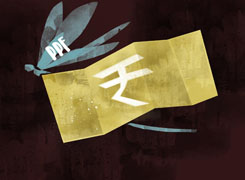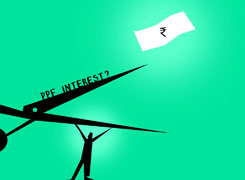How Long Will My PF Account Earn Interest After Leaving MNC?
Ramalingam Kalirajan |10874 Answers |Ask -Follow
Mutual Funds, Financial Planning Expert - Answered on Aug 16, 2024
He has an MBA in finance from the University of Madras and is a certified financial planner.
He is the director and chief financial planner at Holistic Investment, a Chennai-based firm that offers financial planning and wealth management advice.... more

Hi Sir I heve recently left job .My organisation was an MNC. Co is having there own trust for PF.My questions are 1) How long will my account get interest. 2) Can i transfer my Pf amount to EPFO
Interest Accrual on PF After Leaving Job
When you leave a job, your PF account doesn't stop earning interest right away. Here’s what you need to know:
Interest Accrual Period: Your PF account will continue to earn interest for up to 36 months after you leave the job. This is the period during which your account is considered "operative."
Inoperative Account: After 36 months, if there is no contribution or withdrawal, the account becomes inoperative. However, it will still earn interest until you turn 58. This ensures that your savings continue to grow.
Rate of Interest: The interest rate applied will be as per the existing rates declared by the government or the PF trust. These rates may vary yearly, but your account will be credited with interest until it becomes inoperative.
Withdrawal of Interest: You can withdraw the accumulated interest along with your principal amount whenever you decide to settle the PF account. Delaying the withdrawal might be beneficial as your corpus continues to grow.
Tax Implications: Be mindful of tax implications if you withdraw your PF amount before completing 5 years of continuous service. The withdrawn amount may be taxable, including the interest accrued.
Transferring PF from Company Trust to EPFO
Transferring your PF from a company’s private trust to EPFO can be a crucial decision. Here’s what you need to consider:
Possibility of Transfer: Yes, you can transfer your PF from the company trust to EPFO. This is a common practice when moving from a private trust to a new employer registered with EPFO.
Process of Transfer: The process involves filling out the Form 13, which is available online on the EPFO portal or through your new employer. This form needs to be submitted to your new employer, who will facilitate the transfer.
Time Frame: The transfer process can take a few weeks to complete. Ensure that all your details are accurate and that you provide the necessary documents to avoid delays.
Advantages of Transfer: Transferring your PF to EPFO offers several advantages:
Uniform Interest Rate: EPFO offers a standard interest rate that is declared annually by the government. This provides transparency and predictability.
Centralized Management: Your PF will be managed centrally by EPFO, ensuring that your account is updated and secure.
Ease of Access: EPFO provides online access to your PF account, allowing you to monitor your balance, make withdrawals, and apply for loans against your PF easily.
Potential Drawbacks: While transferring to EPFO, you may face some administrative delays or discrepancies in the balance transferred. It's advisable to keep track of your account and follow up if necessary.
Managing Your PF Post-Transfer
Once your PF is transferred to EPFO, you must manage it effectively. Here are some tips:
Nomination Update: Ensure that your nomination details are updated with EPFO. This is crucial for the safety of your funds.
Regular Monitoring: Keep an eye on your PF account through the EPFO portal. Regularly check your balance and ensure that interest is being credited correctly.
Partial Withdrawals: EPFO allows partial withdrawals for specific purposes like marriage, education, or medical emergencies. Familiarize yourself with the conditions and processes to avail these benefits if needed.
Contribution Resumption: If you join a new employer who is also covered under EPFO, your contributions will resume automatically. This will continue to grow your PF corpus.
Portability: Your EPFO account is portable across different jobs. This means that once your PF is with EPFO, future transfers will be seamless, and your savings will be consolidated in one account.
Exploring Alternative Investment Options
Since you've left your job, you may consider reinvesting your PF amount or using it wisely. Here are some options:
Mutual Funds: Actively managed mutual funds can offer higher returns compared to traditional savings schemes. Consulting with a Certified Financial Planner can help you choose the right funds based on your risk appetite.
Public Provident Fund (PPF): If you prefer a safer investment option, PPF is a good choice. It offers tax benefits and a reasonable interest rate, making it suitable for long-term savings.
Fixed Deposits (FDs): While not the highest-return option, FDs offer security and assured returns. You can allocate a portion of your PF withdrawal into FDs to maintain liquidity and safety.
Systematic Investment Plans (SIPs): Regularly investing in SIPs helps in disciplined savings. It also allows you to benefit from market fluctuations over time.
Emergency Fund: Consider setting aside a portion of your PF as an emergency fund. This will ensure that you have liquidity in case of unforeseen circumstances.
Ensuring Financial Security After Job Transition
Transitioning from a job, especially after leaving a stable MNC position, requires careful planning. Here’s how you can secure your financial future:
Budgeting: Create a monthly budget to manage your expenses. This will help you maintain financial discipline and ensure that you don’t dip into your savings unnecessarily.
Insurance Coverage: Review your existing insurance policies. Ensure that you have adequate health and life insurance coverage, especially after leaving your employer-provided benefits.
Retirement Planning: If you haven’t already, now is the time to plan for your retirement. Consider your long-term goals and start investing accordingly.
Consulting a Certified Financial Planner: Seeking professional advice can help you make informed decisions. A CFP can guide you through the complexities of managing your PF and investing it wisely.
Evaluating the Impact of Not Having a Job
Not having a job affects your financial situation. Here’s how to navigate this period:
Income Diversification: Consider alternative sources of income. This could be freelancing, consulting, or even starting a small business. Diversifying your income sources will reduce financial strain.
Skill Enhancement: Use this period to enhance your skills. This can increase your employability and open up new opportunities.
Debt Management: If you have any outstanding loans or debts, prioritize paying them off. This will reduce your financial burden and free up funds for other investments.
Networking: Stay connected with your professional network. This can lead to new job opportunities or collaborations that can benefit your career and financial status.
Finally
Handling your PF after leaving a job is an important decision. Understanding the interest accrual and transfer process can ensure that your savings continue to grow. By making informed choices, you can secure your financial future and navigate through this transition smoothly.
Focus on your long-term goals, and consider consulting with a Certified Financial Planner to make the most of your PF and other investments. Remember, your financial well-being is in your hands, and with the right planning, you can achieve stability and growth.
Best Regards,
K. Ramalingam, MBA, CFP,
Chief Financial Planner,
www.holisticinvestment.in
You may like to see similar questions and answers below
Milind Vadjikar | Answer |Ask -Follow
Insurance, Stocks, MF, PF Expert - Answered on Sep 22, 2024
Milind Vadjikar | Answer |Ask -Follow
Insurance, Stocks, MF, PF Expert - Answered on Dec 18, 2024
Ramalingam Kalirajan |10874 Answers |Ask -Follow
Mutual Funds, Financial Planning Expert - Answered on Aug 04, 2025
Mayank Chandel |2569 Answers |Ask -Follow
IIT-JEE, NEET-UG, SAT, CLAT, CA, CS Exam Expert - Answered on Dec 08, 2025
Mayank Chandel |2569 Answers |Ask -Follow
IIT-JEE, NEET-UG, SAT, CLAT, CA, CS Exam Expert - Answered on Dec 08, 2025

Mayank Chandel |2569 Answers |Ask -Follow
IIT-JEE, NEET-UG, SAT, CLAT, CA, CS Exam Expert - Answered on Dec 08, 2025
Mayank Chandel |2569 Answers |Ask -Follow
IIT-JEE, NEET-UG, SAT, CLAT, CA, CS Exam Expert - Answered on Dec 08, 2025
Mayank Chandel |2569 Answers |Ask -Follow
IIT-JEE, NEET-UG, SAT, CLAT, CA, CS Exam Expert - Answered on Dec 08, 2025
Anu Krishna |1746 Answers |Ask -Follow
Relationships Expert, Mind Coach - Answered on Dec 08, 2025
Ramalingam Kalirajan |10874 Answers |Ask -Follow
Mutual Funds, Financial Planning Expert - Answered on Dec 08, 2025
Samraat Jadhav |2499 Answers |Ask -Follow
Stock Market Expert - Answered on Dec 08, 2025
Ramalingam Kalirajan |10874 Answers |Ask -Follow
Mutual Funds, Financial Planning Expert - Answered on Dec 08, 2025
Radheshyam Zanwar |6737 Answers |Ask -Follow
MHT-CET, IIT-JEE, NEET-UG Expert - Answered on Dec 08, 2025
























